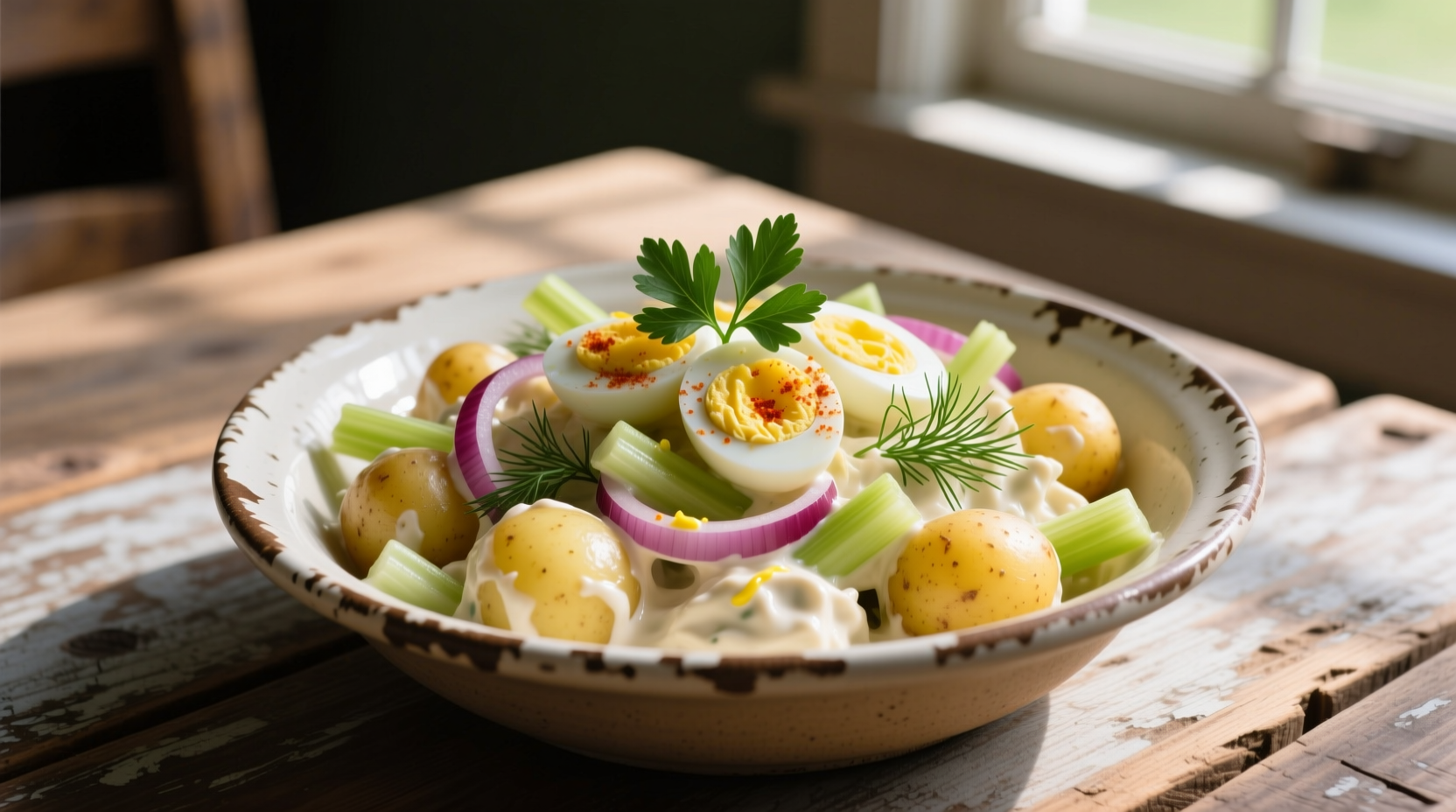The Timeless Appeal of Classic Potato Salad
Nothing says summer gathering quite like a bowl of classic potato salad. This beloved side dish has been a staple at American picnics, barbecues, and family reunions for generations. Unlike trendy food fads that come and go, the traditional potato salad recipe has maintained its popularity because it delivers consistent comfort and familiar flavors that appeal to nearly everyone.
What makes this dish truly special isn't complexity—it's the careful attention to fundamental techniques that transform simple ingredients into something extraordinary. The difference between mediocre potato salad and exceptional potato salad comes down to proper potato selection, precise cooking methods, and balanced dressing proportions. When executed correctly, classic potato salad offers the perfect harmony of creamy, tangy, and savory elements with contrasting textures that keep each bite interesting.
From European Roots to American Tradition
Potato salad's journey began in 16th century Europe after Spanish explorers introduced potatoes from South America. German and French cooks developed early versions of the dish, but it was German immigrants who brought potato salad to America in the 1800s. According to food historians at the National Culinary Review, these early recipes featured vinegar-based dressings rather than the mayonnaise-based versions we know today.
The transition to creamy dressing occurred in the early 20th century when commercial mayonnaise became widely available. By the 1930s, potato salad had become a standard offering at American picnics and church suppers. The dish evolved regionally across the United States, with Southern versions often including mustard and sweet pickles, while Midwestern recipes favored a simpler approach with just mayo and celery.
| Regional Variation | Key Characteristics | Distinctive Ingredients |
|---|---|---|
| Midwestern Classic | Creamy, mild flavor profile | Mayonnaise, white vinegar, celery, onion |
| Southern Style | Tangy with sweet elements | Yellow mustard, sweet pickle relish, paprika |
| German-Inspired | Vinegar-forward, less creamy | Mustard, bacon, vinegar dressing |
| Mid-Atlantic | Rich and complex flavor | Mayo, mustard, hard-boiled eggs, fresh herbs |
Essential Ingredients for Authentic Flavor
The magic of classic potato salad lies in its simplicity. You don't need exotic ingredients—just quality basics prepared correctly. Start with waxy potatoes like Yukon Gold or red potatoes, which hold their shape better than starchy varieties. The dressing should feature high-quality mayonnaise as the base, complemented by yellow mustard for tang and a splash of apple cider vinegar for brightness.
Don't underestimate the supporting players: finely diced celery provides crucial crunch, sweet pickles add subtle sweetness, and red onion delivers a gentle bite. Fresh herbs like dill or parsley elevate the flavor profile without overpowering the dish. For the best results, use fresh hard-boiled eggs with bright yellow centers—this indicates proper cooking time and temperature.

Step-by-Step Preparation Guide
Perfect Potato Cooking: Start by washing unpeeled potatoes thoroughly. Place them in a large pot, cover with cold water by two inches, and add one tablespoon of salt. Bring to a gentle boil, then reduce heat to maintain a simmer. Cook until just tender when pierced with a fork—typically 15-20 minutes depending on size. Overcooking causes potatoes to disintegrate in the salad. Immediately drain and let cool slightly before peeling and cutting.
Dressing Technique: While potatoes cook, prepare the dressing. In a separate bowl, combine 1½ cups mayonnaise, ¼ cup yellow mustard, 2 tablespoons apple cider vinegar, 1 teaspoon sugar, ½ teaspoon salt, and ¼ teaspoon black pepper. Whisk until smooth. The sugar balances the acidity—don't skip this element as it creates the signature flavor profile.
Assembly Process: Gently fold the warm (not hot) potato cubes into the dressing along with ½ cup finely diced celery, ¼ cup sweet pickle relish, 2 chopped hard-boiled eggs, and 2 tablespoons finely minced red onion. Handle the potatoes carefully to prevent mashing. Cover and refrigerate for at least four hours—this chilling time allows flavors to meld and creates that distinctive creamy texture.
Avoiding Common Potato Salad Pitfalls
Even experienced cooks make mistakes with potato salad. The most frequent error is using the wrong potato variety—Russets become too mushy. Another common issue is adding dressing to hot potatoes, which causes the mayo to break. Always let potatoes cool slightly before mixing.
Many home cooks also underestimate the importance of proper chilling time. Potato salad served immediately lacks the developed flavor of properly rested salad. Additionally, adding too much dressing creates a soggy mess—start with less and add more only if needed. Finally, resist the urge to overmix, which breaks down the potato pieces and creates an unappealing texture.
Serving and Storage Guidelines
Classic potato salad shines at outdoor gatherings but requires careful temperature management. When serving at picnics, keep the bowl nestled in ice to maintain food safety. The USDA recommends keeping potato salad below 40°F (4°C) and not leaving it out for more than two hours (one hour when temperatures exceed 90°F/32°C).
For leftovers, store in an airtight container in the refrigerator for up to three days. The flavor often improves on day two as ingredients continue to meld. Never freeze potato salad, as the mayonnaise separates and potatoes become grainy when thawed. If you notice any off odors or unusual texture, discard the salad immediately—better safe than sorry with perishable dishes.
Thoughtful Variations for Different Occasions
While purists prefer the traditional recipe, thoughtful variations can accommodate different preferences without compromising the dish's essential character. For a lighter version, substitute half the mayonnaise with Greek yogurt. Add chopped fresh dill or chives for herbal notes that complement rather than overpower.
When serving at formal events, consider piping the salad into individual portions using a pastry bag for elegant presentation. For backyard barbecues, adding a few chopped bacon pieces provides a smoky contrast that many guests appreciate. The key to successful variations is maintaining the fundamental creamy-tangy balance that defines classic potato salad while introducing complementary elements.











 浙公网安备
33010002000092号
浙公网安备
33010002000092号 浙B2-20120091-4
浙B2-20120091-4